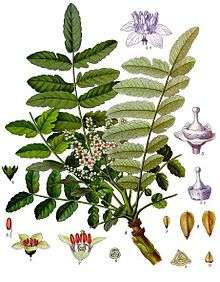Boswellia
| Boswellia | |
|---|---|
 | |
| Scientific classification | |
| Kingdom: | Plantae |
| (unranked): | Angiosperms |
| (unranked): | Eudicots |
| (unranked): | Rosids |
| Order: | Sapindales |
| Family: | Burseraceae |
| Genus: | Boswellia Roxb. ex Colebr.[1] |
| Species | |
|
see Selected species | |
Boswellia is a genus of trees in the order Sapindales, known for their fragrant resin which has many pharmacological uses, particularly as anti-inflammatories. The Biblical incense frankincense was an extract from the resin of the tree Boswellia sacra, and is now produced also from B. frereana.[2]
Frankincense
There are four main species of Boswellia which produce true frankincense. B. sacra (synonyms B. carteri and B. bhaw-dajiana), B. frereana, B. papyrifera, and B. serrata,[2][3] and each type of resin is available in various grades. The grades depend on the time of harvesting, and the resin is hand sorted for quality.
Description
Boswellia are moderate-sized flowering plants, including both trees and shrubs, and are native to tropical regions of Africa and Asia. The distributions of the species are primarily associated with the tropics.[4] The greatest diversity of species presently is in Africa and India.[4]
The plants are dioecious.[5] The flowers may have 4-5 faintly connate but imbricate sepals with an equal number of distinct, imbricate petals.[5] Also, the stamens, that may contain nectar discs, have distinct glabrous filaments that come in 1-2 whorls and in numbers equaling or twice the number of petals; the tricolporate pollen is contained within 2 locules of the anthers that open longitudinally along slits.[5] The gynoecium contains 3-5 connate carpels, one style, and one stigma that is head-like to lobed.[5] Each locule of the superior ovary has 2 ovules with axile placentation that are anatropous to campylotropous.[5] The 1-5 pitted fruit is a drupe that opens at maturity.[5] The endosperm is usually lacking in the embryo.[5]
Medicinal uses
Boswellia has long been used in Ayurvedic medicine. Recently, the boswellic acids that are a component of the resin it produces have shown some promise as a treatment for asthma and various inflammatory conditions.[6] In West Africa, the bark of Boswellia dalzielii is used to treat fever, rheumatism and gastrointestinal problems.[7] Boswellia incense may even relieve depression.[8]
Selected species
- B. ameero Balf.f.
- B. boranensis Engl.
- B. bricchettii (Chiov.) Chiov.
- B. bullata Thulin
- B. chariensis Guillaumin
- B. dalzielii Hutch.
- B. dioscoridis Thulin
- B. elegans Engl.
- B. elongata Balf.f.
- B. frereana Birdw.
- B. globosa Thulin
- B. hildebrandtii Engl.
- B. holstii Engl.
- B. madagascariensis Capuron
- B. microphylla Chiov.
- B. multifoliolata Engl.
- B. nana Hepper
- B. neglecta S.Moore
- B. odorata Hutch.
- B. ogadensis Vollesen
- B. ovalifoliolata N.P.Balakr. & A.N.Henry
- B. papyrifera (Del.) Hochst.
- B. pirottae Chiov.
- B. popoviana Hepper
- B. rivae Engl.
- B. ruspoliana Engl.
- B. sacra Flueck.
- B. serrata Roxb. ex Colebr. (type)
- B. socotrana Balf.f.
- List source :[3]
References
- ↑ The genus Boswellia, and the type Boswellia serrata, were first described and published in Asiatic Researches 9: 379. 1807. "Name - Boswellia Roxb. ex Colebr.". Tropicos. Saint Louis, Missouri: Missouri Botanical Garden. Retrieved November 24, 2012.
Type Specimens: T: Boswellia serrata Roxb. ex Colebr.
- 1 2 Tucker, A. (1986). "Frankincense and myrrh". Economic Botany. 40 (4): 425–433. doi:10.1007/bf02859654.
- 1 2 "TPL, treatment of Boswellia". The Plant List; Version 1.1. (published on the internet). Royal Botanic Gardens, Kew and Missouri Botanical Garden. 2013. Retrieved September 24, 2014.
- 1 2 Weeks, A., Daly, D.C. and B.B. Simpson. 2005. The phylogenetic history and biogeography of the frankincense and myrrh family (Burseraceae) based on nuclear and chloroplast sequence data. Molecular Phylogenetics and Evolution, 35: 85-101.
- 1 2 3 4 5 6 7 Judd, W.S., Campbell, C.S., Kellogg, E.A., Stevens, P.F., and M.J. Donoghue. 2008. Plant Systematics: A Phylogenetic Approach 3rd ed. Sinauer Associates, Inc., Sunderland, Massachusetts, USA.
- ↑ Gupta I, Gupta V, Parihar A, et al. Effects of Boswellia serrata gum resin in patients with bronchial asthma: results of a double-blind, placebo-controlled, 6-week clinical study. European Journal of Herbal Medicine 1998; 3:511-14.
- ↑ Arbonnier 2002. Arbres, arbustes et lianes des zones sèches de l'Afrique de l'Ouest
- ↑ "Incensole acetate, an incense component, elicits psychoactivity by activating TRPV3 channels in the brain", The FASEB Journal, 20 May 2008.
External links
| Wikisource has the text of the 1921 Collier's Encyclopedia article Boswellia. |
- Phytochemical Investigations on Boswellia Species
- Boswellia Serrata
- Chemotaxonomic Investigations on Resins of the Frankincense Species Boswellia papyrifera, Boswellia serrata and Boswellia sacra, respectively, Boswellia carterii: A Qualitative and Quantitative Approach by Chromatographic and Spectroscopic Methodology, Paul, M., Dissertation, Saarland University (2012)